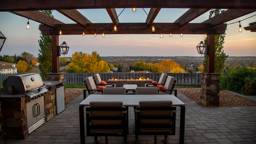Solar lights have always been a popular choice to illuminate those dark stretches from dock to cabin. However, until recently, those lights often added about as much illumination as the average firefly. With advances in LED and photovoltaic technology, today’s solar lights are far more utilitarian than their predecessors. Here’s how to make the most of this low-maintenance, easy-to-install, and green source of light.
Update to LED
Ditch those old solar lights with filament lighting and upgrade to LED lights. Light-emitting diodes do not generate waste heat, and they are almost always coupled with more advanced photovoltaic cells. The end result is more light intensity and a longer light cycle, even after a cloudy, short winter day.
Update to LED
Ditch those old solar lights with filament lighting and upgrade to LED lights. Light-emitting diodes do not generate waste heat, and they are almost always coupled with more advanced photovoltaic cells. The end result is more light intensity and a longer light cycle, even after a cloudy, short winter day.
COOL PRODUCT
WE LOVE!
Symphony of Color
The Four Seasons Courtyard Fiber Optic Solar Stake Light is sure to be a hit at Fourth of July parties this summer. MSRP is $10 each, available from True Value Hardware stores or www.truevalue.com.
WE LOVE!
Symphony of Color
The Four Seasons Courtyard Fiber Optic Solar Stake Light is sure to be a hit at Fourth of July parties this summer. MSRP is $10 each, available from True Value Hardware stores or www.truevalue.com.
Charge before you install
The day you buy solar lights is not the day to plant them in the ground, tempting as it may be. Use the first four to five days post-purchase to place your lights in full sunlight, which will fully charge the batteries and lead to better performance. You can use these days to plan out the locations for the lights.
Avoid the lawnmower blues
If possible, place pedestal solar lights in clear but ummowed areas, such as flower or rock gardens. This cuts down on the amount of weed trimming you’ll need to perform, while still allowing for enough sunlight to recharge the panels. A low-maintenance option is to roll out heavy-duty landscape fabric on one or both sides of the pathway, spread mulch over the top, and then install solar lights in the “mow free” zone.
The day you buy solar lights is not the day to plant them in the ground, tempting as it may be. Use the first four to five days post-purchase to place your lights in full sunlight, which will fully charge the batteries and lead to better performance. You can use these days to plan out the locations for the lights.
Avoid the lawnmower blues
If possible, place pedestal solar lights in clear but ummowed areas, such as flower or rock gardens. This cuts down on the amount of weed trimming you’ll need to perform, while still allowing for enough sunlight to recharge the panels. A low-maintenance option is to roll out heavy-duty landscape fabric on one or both sides of the pathway, spread mulch over the top, and then install solar lights in the “mow free” zone.
What about those shady areas?
Creating a well-lighted solar pathway can require unique placement and styles of lights. Avoid placing solar lights in shady areas, which don’t offer good charging. However, these shady spots also block out ambient nighttime light from the moon, stars, and yard lights, and are often the areas most in need of lighting after sunset. So what to do? For these areas, consider solar lights with separate charging panels, which allow you to charge in the sun and illuminate in the shade. Separate-panel solar lights also tend to provide more illumination, and can incorporate up to 16 LEDs instead of the standard four. Separate panels are also nice because they can be tilted toward the sun, further increasing effectiveness; optimal tilts are 30° to the south in summer, and 45° in the wintertime.
Lighting from above
Solar spotlights can be used to shine down the path from the cabin’s eave, a tree, or other elevated structure. An added bonus with this approach is that elevated lights often have optimal charging power because of reduced light obstructions. Be sure to consider full cutoff-style fixtures that shine light downward, to lessen light pollution.
Creating a well-lighted solar pathway can require unique placement and styles of lights. Avoid placing solar lights in shady areas, which don’t offer good charging. However, these shady spots also block out ambient nighttime light from the moon, stars, and yard lights, and are often the areas most in need of lighting after sunset. So what to do? For these areas, consider solar lights with separate charging panels, which allow you to charge in the sun and illuminate in the shade. Separate-panel solar lights also tend to provide more illumination, and can incorporate up to 16 LEDs instead of the standard four. Separate panels are also nice because they can be tilted toward the sun, further increasing effectiveness; optimal tilts are 30° to the south in summer, and 45° in the wintertime.
Lighting from above
Solar spotlights can be used to shine down the path from the cabin’s eave, a tree, or other elevated structure. An added bonus with this approach is that elevated lights often have optimal charging power because of reduced light obstructions. Be sure to consider full cutoff-style fixtures that shine light downward, to lessen light pollution.


 Thinkstock.com
Thinkstock.com  Thinkstock.com
Thinkstock.com 









